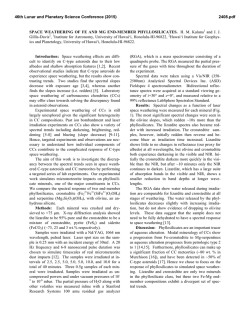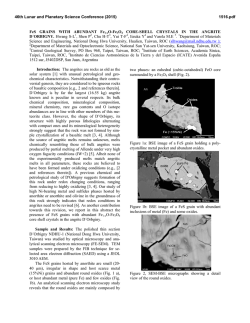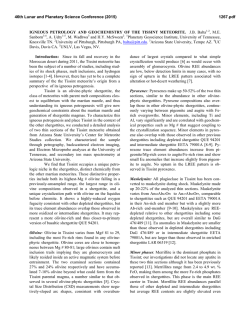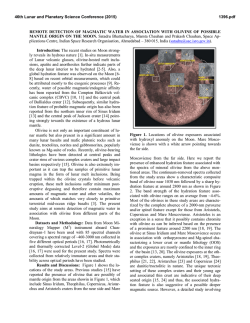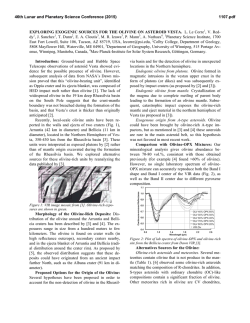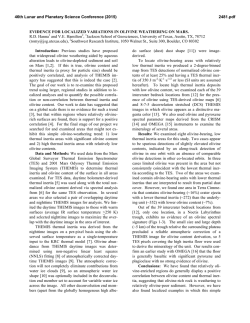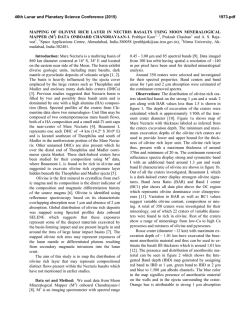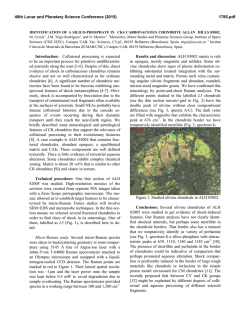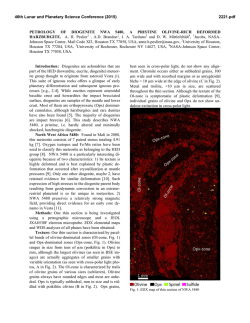
1890
46th Lunar and Planetary Science Conference (2015) 1890.pdf LABORATORY SIMULATION OF THE EFFECT OF FES ON SPACE WEATHERING. M. Okazaki1, S. Sasaki1, A. Tsuchiyama2, A. Miyake2, T. Matsumoto2, T. Hirata2 and T. Hiroi3, 1Department of Earth and Space Science, Osaka University, 1-1 Machikaneyama, Toyonaka, Osaka 560-0043, Japan ([email protected]), 2 Department of Geology and Mineralogy, Kyoto University, Kitashirakawaoiwake-cho, Sakyo, Kyoto, 606-8502, Japan, 3Department of Earth, Environmental and Planetary Sciences, Brown University, Providence, RI 02912, U.S.A. Introduction: Color difference of S-type asteroids from ordinary chondrites can be explained by space weathering. In the standard model of space weathering, changes of surface optical properties of airless silicate bodies – reddening, darkening, and suppression of absorption bands – are explained by nanophase metallic iron (npFe0) particles formed on regolith particles by micrometeorite bombardment as well as solar wind ion implantation [1]. These particles are found in lunar soils and asteroidal regolith [2-3]. The spectral change of space weathering can be reproduced using nanosecond pulse laser irradiation simulating high velocity dust impacts. The formation of npFe0 particles within the vapor-deposited rim of laserirradiated olivine and pyroxene grains was comfirmed using a transmission electron microscope (TEM) [4]. However, the degree of space weathering should depend on mineral compositions such as olivine/pyroxene ratio [5] and iron abundance. In 2010, Hayabusa spacecraft brought back particles from the surface of asteroid 25143 Itokawa. There was a deposited rim (~10 nm) amorphous layer containing nanophase (np) FeS and MgS based on elemental analysis of surface layers [3]. Also, one of Itokawa particles (~40 µm) was composed mainly of FeS [6]. npFeS particles are observed in lunar samples and gas rich meteorites. The FeS contents are 2 wt% (S/Si ~ 0.1) in ordinary chondrites and 8 wt% (S/Si ~ 0.050.4) in carbonaceous chondrites and enstatite chondrites [7]. Therefore, FeS (MgS) would be also responsible for space weathering of airless bodies, and in this study the effect of FeS on the surface optical properties of silicate bodies was examined. Experimental: In order to simulate space weathering, the same method as in a previous study by our group [8] was adopted in this study. A solid-state NdYAG pulse laser beam (wavelength: 1064 nm) with pulse duration of 6-8 nanoseconds was used, which is comparable with real dust impacts. Repetition rate was 20 Hz, energy of each laser pulse was 10 mJ, and the beam diameter was focused into 500 μm. A semiautomatic X-Y stage was used for a uniform irradiation of each sample. An area irradiated with one scan of laser is called “1shot”, and if the same area is scanned for the second time after resetting the X-Y stage, it is called “2shot”. Samples used for our experiments are olivine (from San Carlos) containing 8.97 wt% FeO, FeS, and metallic Fe. The samples were crushed by an electric tungsten ball mill and passed through sieves. In this study, particle size range of all the samples were 45-75 µm except the 95 wt% olivine + 5 wt% FeS mixture wherein the FeS powder was <45 µm in order to examine the effect of increased cross-sectional area. The remaining mixture samples prepared were 100 wt% olivine, 90 wt% olivine + 10 wt% Fe, 90 wt% olivine + 10 wt% FeS, and 80 wt% olivine + 20 wt% FeS. Each powder sample was filled in a Cu dish of 13 mm in diameter and 1 mm in depth and pressed into a pellet at a pressure of 2 tons for 2 minutes. After the pulse laser irradiation, bidirectional refrectance spectra of samples were measured over the wavelength range of 250-2500 nm. Incidence and emission angles were 30 and 0 degrees from the vertical direction, respectively. In addition, the sample surfaces were observed by a high resolution microscope (HRM), a scanning electron microscope (SEM) and a TEM at Kyoto University. Results and Discussion: Reflectance spectra of olivine and an olivine-FeS mixture before and after pulse-laser irradiation are plotted Fig. 1 as examples. Fig. 1: Spectral changes of olivine and olivine-FeS mixture pellet samples by pluse laser irradiation. Two spectral parameters, spectral slope (SS) and overall brightness (OB), are defined to express the space-weathering trend of our samples: SS = R(2500) / R(560) OB = R(2500) R(): Reflectance at nm in wavelength 46th Lunar and Planetary Science Conference (2015) We calculated the spectral slope (SS) at 560 and 2500 nm avoiding absorption bands as a reddening index, and overall brightness (OB) at 2500nm avoiding reddening effect as a darkening index. Normalized SS and OB values of unirradiated and irradiated samples are plotted in Fig. 2. Fig. 2: Reddening and darkening trend of olivine, olivine-Fe mixture, and olivine-FeS mixtures. First, the 100 wt% olivine pellet was irradiated with laser, and opitical reddening was observed, which was the same result as in [8]. The 100 wt% olivine pellet showed 27% increase in SS for 1shot, and even more increase for 2shot, which is a characteristic of space weathering. Spectral changes of 90 wt% olivine + 10 wt% FeS pellet involved not only reddening but also darkening: 39% increase in SS and 15% decrease in OB for 1shot. For comparison, the 90 wt% olivine + 10 wt% Fe mixture sample was also irradiated, which showed only reddening but not much darkening: 41% increase in SS and 4% decrease in OB. Therefore, adding FeS promotes a different kind of spectral change from adding Fe, especially overall darkening. Also, an additional mixture pellet sample of 95 wt% olivine (45-75 µm) + 5 wt% FeS (<45 µm) was prepared and irradiated with laser in the same manner. Its reflectance spectrum after irradiation showed more reddening and more darkening: 50% increase in SS and 28% decrease in OB for 1shot. This result suggests that smaller FeS particles are more effective in producing space weathering effects because of its increased cross-sectional area. Also, adding FeS makes overall darkening. As shown in Fig. 3, we observed changes of each sample surface using a HRM and a field-emission (FE) SEM. Each sample surface looked smoother after laser irradiation. It might be caused by vapor deposition or melting. Irradiated olivine-FeS mixtures showed metal (Fe?)-looking grains on the surface and olivine grains 1890.pdf around FeS looked more darkened. This observation suggests that sulfur is vaporized and trapped in olivine. In order to identify the products formed by laser irradiation as the cause of the observed optical changes, an olivine particle was picked up from the area darkened after laser irradiation and prepared by focused ion beam (FIB) for TEM observation. There was an amorphous rim (100 nm) on the surface and nanometer-size particles in lower and upper rims. The lattice distance of the lower-layer nanoparticles was 2.00 Å, indicating -Fe. In contrast, the lattice distance of the upperlayer nanoparticles was 1.82 Å, indicating neither troillite FeS nor Fe. From energy dispersive spectrometry (EDS) results, amorphous rim has less silicate and there is Fe in both the lower and upper layers. Sulfur exists by only a small amount in the upper layer. Thus, although npFe0 particles have been found, npFeS particles have not been found at the moment. Mineral Amorphous rim C-dep Fig. 3: Amorphous rim of 95 wt% olivine (45-75 µm) + 5 wt% FeS (<45 µm) sample for 1shot. Conclusion: FeS can promote vapor deposition type space weathering, especially overall spectral darkening extending toward long wavelengths. Smaller FeS particles are more effective in producing the space weathering effects. Although npFeS particles have not been found yet, they are likely causing the observed spectral changes, and the search for npFeS particles is still continuing. References: [1] Hapke B. et al. (2001) J. Geophys. Res. 106, 10039-10073. [2] Noble S. K. et al. (2011) Meteoritics & Planet. Sci., 45, 2007-2015. [3] Noguchi T. et al. (2011) Science 333, 1121-1124. [4] Sasaki S. et al., (2001) Nature 410, 555-557. [5] Hiroi T. and Sasaki S. (2001) Meteoritics and Planet. Sci., 36, 1587-1596. [6] Yada T. et al. (2014) LPSC XLV, Abstract #1759. [7] Nittler L. R. et al. (2004) Antarct. Meteorite Res., 17, 233-253. [8] Yamada M. et al. (1999) Earth Planets Space 51, 1255-1265.
© Copyright 2026
